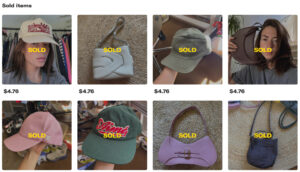Secondhand, first choice: How platforms and creators are powering the resale boom
As platforms and creators turn resale into a driver of culture, community, and commerce, circular fashion is stepping into the mainstream - proving it can rival traditional retail while reshaping what Gen Z expects from brands.
October 9, 2025

Once considered a niche market for bargain hunters, secondhand fashion has evolved into a cultural and commercial powerhouse. In 2025, pre-loved luxury and social thrift culture are driving mainstream conversations about sustainability, creativity, and style.
What’s changing most is who is leading it. Creators, resale platforms, and major fashion brands are all influencing the next chapter of circular fashion – now functioning much like the wider fashion industry itself, but with the cultural nuance and sustainability Gen Z expects from the brands they love.
With players like ASOS, H&M, and Zara launching secondhand channels within their ecommerce ecosystems, the sector is moving from the sidelines to the centre of fashion’s social commerce future.
For example, Pinterest, along with resale leaders like Depop and Vestiaire Collective, are blending social commerce, creator influence, and trend-led storytelling to make circular fashion aspirational.
Pinterest and Vestiaire Collective open the digital thrift shop
Earlier in September this year, Pinterest and Vestiaire Collective launched The Thrift Shop – an immersive digital resale experience that merges seasonal trend discovery with curated luxury fashion. The collaboration showcases how inspiration and sustainability can coexist, while positioning Pinterest as an ideal discovery platform for circular style.
Unlike platforms built around real-time posting, Pinterest functions as a visual search engine where users arrive with intention – planning wardrobes, home makeovers, or lifestyle changes. This purposeful browsing makes it a natural entry point for resale brands. Here, users are not passively scrolling; they are actively seeking looks, aesthetics, and ideas that influence future choices.
For Vestiaire Collective, the partnership provides a fresh storytelling layer for its mission to extend the lifecycle of luxury fashion. Within The Thrift Shop, the brand has curated a collection of pre-loved designer pieces inspired by Pinterest’s Autumn 2025 Trend Report, featuring:
- Gourmand brown – rich, chocolatey tones and tactile materials.
- Contemporary victorian – romantic lace, drama, and vintage silhouettes.
- Japandi streetwear – minimalism with an urban edge.
These themed boards connect visual inspiration directly to shoppable, sustainable products. The result is an experience that mirrors the elegance of luxury retail while reinforcing the environmental value of buying secondhand.
“Pinterest users come with an open mind and an eye for the future,” a Vestiaire spokesperson noted. “By curating secondhand through trends, we’re showing that circular fashion isn’t an alternative – it’s integral to style’s evolution.”
This collaboration exemplifies how social commerce and sustainable retail now intersect. Pinterest’s discovery tools identify emerging consumer desires; Vestiaire Collective translates those insights into tangible, trend-aligned inventory. Together, they reframe resale as the first, not final, choice in fashion.
Victoria Paris x Depop: Turning resale into a viral moment
While Pinterest and Vestiaire Collective structure resale around trends, Depop partnered with influencer Victoria Paris to turn it into an event: Paris – known for her lifestyle content and candid community connection – sparked a viral moment with a Depop activation that sold out within minutes. She teased a “$5 drop” of designer items from her wardrobe, prompting fans to redownload the app, set alerts, and queue virtually for the release. Traffic surged, with individual listings attracting hundreds of thousands of views globally.
Though discussion online questioned whether the campaign was a planned paid partnership as formal disclosure appeared only on launch day, it nevertheless served as a best case for creator-led commerce. Depop effectively leveraged Paris’s influence to (re-)engage users and activate the community effectively.
For Paris, the stunt amplified her brand as relatable and generous, while subtly reinforcing her connection to the Depop ecosystem, as her rise to popularity started from her promoting her Depop on TikTok during the pandemic. For the platform, it proved that resale can thrive on hype and emotion as much as on sustainability messaging – making it no different from commercial fashion brands in the space. It underscores how creators can build their own storefronts – even for the circular economy with their audiences as communities of taste and trust. What began as casual “closet cleanouts” has evolved into high-impact campaigns that blend authenticity with strategic brand partnerships. By activating their communities, brands can convert engagement into sales and avoid falling behind creators who are setting the pace in social commerce.
Why secondhand fashion is thriving
Several converging forces are propelling secondhand fashion into the mainstream:
- Economic reality meets cultural aspiration.
As cost-consciousness grows, buying pre-loved is now both financially smart and culturally empowered. It signals discernment and individuality, not compromise. - Algorithms reward discovery.
Platforms like Pinterest, TikTok, and Depop are optimised for trend exploration. Algorithmic storytelling helps used items travel faster and wider than ever. - Circular fashion as a badge of identity.
Sustainability has evolved beyond moral messaging. Resale now reflects taste, values, and insider knowledge – aligning environmental awareness with aesthetic sophistication.
From discovery to purchase: The new resale journey
What’s emerging is a seamless digital ecosystem connecting inspiration, intention, and purchase. Pinterest offers the discovery layer, while Vestiaire Collective provides the curated product. And in Depop’s case, creators like Victoria Paris supply the cultural momentum that makes resale emotionally resonant – and converts rapidly.
The collaborations demonstrate how resale can exist within trend forecasting rather than outside of it, and how creators can mobilise communities at scale to drive excitement around secondhand retail.
For marketers, the insight is clear: resale isn’t a separate category in fashion – it can be integrated just like any ecommerce channel. When brands and creators frame secondhand fashion as aspirational, sustainable, and socially engaging, they unlock new pathways for loyalty, growth and discovery commerce.
Latest News ☕

Millennials Rewind: Social Engagement in 2025, Top Platforms & the Brands They Still Love
December 4, 2025
Think millennials checked out of social media? Think again. In 2025, they were more engage...

Social media drives Black Friday sales: The first stats are in
December 1, 2025
Black Friday 2025 marks social commerce's breakthrough moment. With sales up 54.5% and hou...

The viral moments that broke the internet in 2025
November 29, 2025
In 2025, viral trends evolved from fleeting moments into cultural phenomena that redefined...


